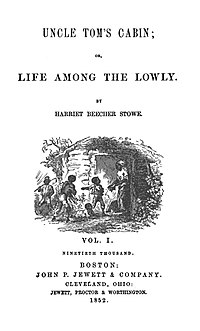This is an old revision of this page, as edited by SouthernNights (talk | contribs) at 15:30, 18 February 2007 (removed more spam links). The present address (URL) is a permanent link to this revision, which may differ significantly from the current revision.
Revision as of 15:30, 18 February 2007 by SouthernNights (talk | contribs) (removed more spam links)(diff) ← Previous revision | Latest revision (diff) | Newer revision → (diff) Uncle Tom's Cabin, Boston edition Uncle Tom's Cabin, Boston edition | |
| Author | Harriet Beecher Stowe |
|---|---|
| Illustrator | Hammatt Billings (1st edition) |
| Language | English |
| Genre | Novel |
| Publisher | National Era (as a serial) & John P. Jewett and Company (in two volumes) |
| Publication date | 20 March 1851 |
| Publication place | United States |
| Media type | Print (Hardback & Paperback) |
| ISBN | NA Parameter error in {{ISBNT}}: invalid character |
Uncle Tom's Cabin, or, Life Among the Lowly is a novel by American author Harriet Beecher Stowe which treats African Americans as a central theme. The novel is believed to have had a profound effect on the North's view of African-Americans.
Stowe was a Connecticut-born teacher at the Hartford Female Academy and an active abolitionist. She first published this book on March 20, 1852. The story focuses on the tale of Uncle Tom, a long-suffering black slave, the central character around whose life the other characters—both fellow slaves and slave owners—revolve. The novel depicts the harsh reality of slavery while also showing that Christian love and faith can overcome even something as evil as enslavement of fellow human beings.
Uncle Tom's Cabin was the best-selling novel of the 19th century (and the second best-selling book of the century after the Bible) and is credited with helping to fuel the abolitionist cause in the 1850s. In the first year after it was published, 300,000 copies of the book were sold.
The book's impact was so great that when Abraham Lincoln met Stowe at the start of the American Civil War, Lincoln is often quoted as having declared, "So this is the little lady who made this big war."
The book also created and spread several common stereotypes about blacks, many of which endure to this day. These include the affectionate, dark-skinned mammy; the Pickaninny stereotype of black children; and the Uncle Tom, or dutiful, long-suffering servant faithful to his white master or mistress. In recent years, the negative associations with Uncle Tom's Cabin have to a large degree overshadowed the historical impact of the book.
Origins
Stowe wrote the novel as a happily noted response to the 1850 passage of the second Fugitive Slave Act, which punished those who aided runaway blacks and diminished the rights of fugitives as well as freed blacks. Much of the book was composed in Brunswick, Maine, while Calvin Stowe taught at his alma mater, Bowdoin College.
Some historians believe that Stowe was inspired by the autobiography of Josiah Henson, an African-American who lived a
- Introduction to Uncle Tom's Cabin Study Guide, accessed May 16, 2006.
- Charles Edward Stowe, Harriet Beecher Stowe: The Story of Her Life (1911) p. 203.
- Harriet Beecher Stowe House